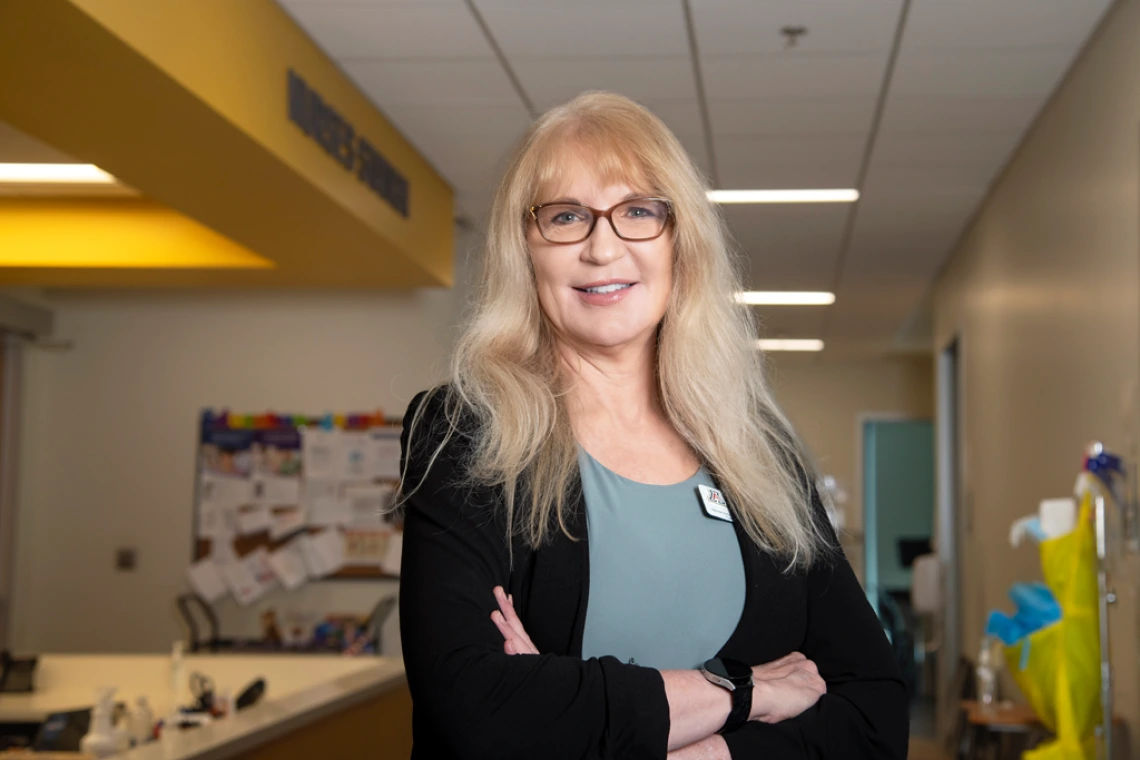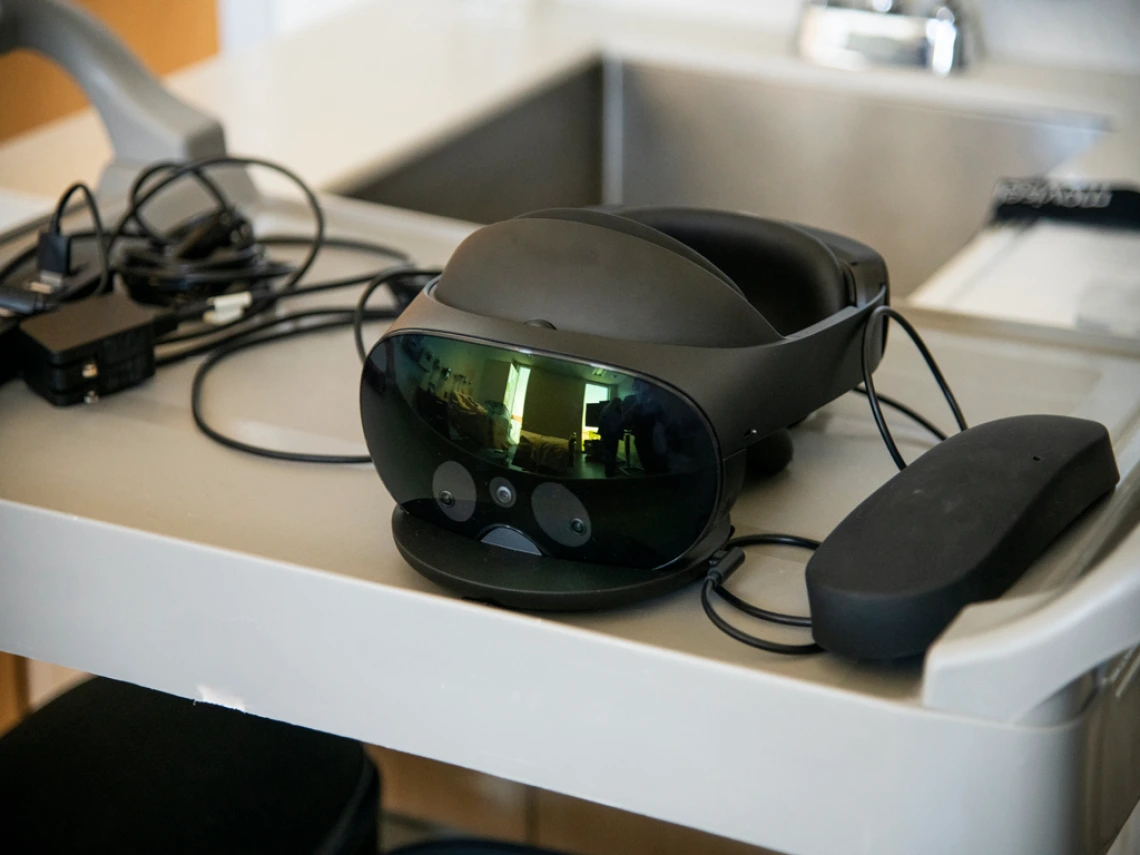Gilbert simulation center gets student nurses ready for real world

Dr. Janine Hinton in the Simulation Lab in Gilbert.
The first time she saw him, Janine Hinton, PhD, was captivated. That glimpse changed the course of her career.
The fact he didn’t notice her didn’t matter. How could he? He was a mannikin being wheeled past the door of the nursing class Hinton was teaching in a community college.
“Oh my gosh! If we can have this as a patient, think of the training that we can do with our students!” she thought.
From that early “aha!” moment, Hinton saw the potential for simulators to help nursing students be better prepared for the situations they would face in the real world. She was already familiar with the role simulation could play in training because her father was an airplane pilot who used simulators already.
“Simulation training is essential in nursing education because it enhances learning, builds clinical competence, fosters critical thinking, and prepares students for real-world clinical practice in a safe and supportive environment,” said Brian Ahn, PhD, dean of the College of Nursing.
Whether it is creating difficult labor-and-delivery scenarios, treating patients who are resistant to help or even building familiarity with what a nurse would find in a typical hospital medication room, the simulation center at the University of Arizona College of Nursing in Gilbert was designed with nurses in mind. The Arizona Simulation Technology and Education Center in the Health Sciences Innovation Building in Tucson helps all Health Sciences colleges including Nursing advance their missions while also training other community organizations. However, the smaller Gilbert’s center has one goal in mind – make nurses better.
“That's my passion,” Hinton said. “How can I help nurses build these skills and experiences and escalate their preparation to work independently in the workforce?”
“The skills that I’ve learned using the simulations has been a great opportunity to continue to enhance my skills,” said Clarissa Padilla, who will graduate this month with a Bachelor of Science in Nursing-Integrative Health. “A lot of times in my preceptorship at Banner - University Medical Center Phoenix, my lead nurse would tell me to grab something from the supply room like an IV start kit or foley. Because I remember using this in simulation, I know exactly what I’m looking for and don’t waste time running around the unit trying to find things. That’s where the simulation skills become a great advantage because I know what it looks like and how to use it because I’ve been doing this in simulation.”
Simulation saves training time
Hinton, an associate clinical professor and director of the Steele Innovative Learning Center as well as a member of BIO5, is in charge of simulation-based education for the college in both Gilbert and Tucson. Because of her work and the work of others at the college, the Arizona State Board of Nursing allows nurses to use one hour of simulation to count as two hours of clinical time.
The simulation training is robust. The facility has a completely immersive, 360-degree, video-based virtual reality setup that students use routinely as well as a digital immersive virtual reality that researchers are using in experimental ways. This includes extended reality and virtual reality spaces. The extended reality works with artificial intelligence and biosensors to allow students and researchers the opportunity to do more than game-ify their learning.
“It’s baked into the curriculum so that it provides experiences such as if there is a patient with vision and hearing problems. The students can wear the headset, see the patient’s hands as if they are theirs. It’s a powerful way to help our students understand the patient experience with different types of presentations,” Hinton said.
This experience helps UArizona nursing students gain confidence.
“At least if they’ve experienced using the simulation, they can bring down the stress level they might be feeling in front of a real patient,” said Kelleigh Beatty, a lecturer in Gilbert. “We’ll do an obstetrical simulation where the baby is delivered and they have to give an injection to a baby. Then, when they are in front of a real baby who came from a real mom, they’re more confident with their skills. They’re not shaking. They’re not hesitant. They got all their nerves out through the simulations and they are ready to go.”
When lives are at stake, confidence and experience in certain scenarios builds the muscle memory nurses need in chaotic situations. More than just practicing on a low-fidelity mannikin or on each other, the sim center gives students the opportunity to work through a scenario as the technology team throws obstacles at them – confusing orders, a patient who is reticent to comply or vitals crashing.
The team in Gilbert works in collaboration with former UArizona Systems and Industrial Engineering professor Young-Jun Son, PhD, the James J. Solberg Head and Ransburg Professor at the Purdue University School of Industrial Engineering, and Kamelia Sepanloo, a doctoral student in the School of Industrial Engineering at Purdue who was also at UArizona. “Working with the UArizona nursing students has been a great experience for us as they bring enthusiasm, dedication, and a strong desire to learn and make a difference in healthcare,” said Son. “By participating in our pilot studies, they have provided valuable feedback on our system's usability, functionality, and effectiveness and helped us refine the system to better meet the needs of health care professionals.”
“We can guide it the way we want it to go,” Beatty said. And if the student struggles, they can do it over and over again.
“When they are with a real patient,” Beatty added, “they can remember ‘Oh, I did this in simulation and this is how we dealt with it and this is how I’m going to use this in real life.’”
Making nursing students ready for patients
Padilla said her time in the sim center as a student and student worker helped ease the transition to hands-on nursing and alleviated some of the nerves of working with real patients. When she begins her full-time role at Banner after graduation and passing her certification, she’ll receive additional simulation training from the hospital.
“I think it’s a great opportunity for students to have this experience,” she said. “It’s just incredible how we have those tools to really practice.”
Beatty agreed.
“When I went to nursing school, we did not have simulation at all,” Beatty said. “We basically learned a few skills and then we were just sent out onto the clinical floor to work with real patients. And I remember being very stressed out and not ready.”
Now student nurses are better prepared through simulation.
A version of this story first appeared on Health Sciences Connec
A version of this story first appeared on Health Sciences Connect


